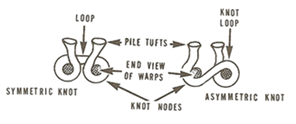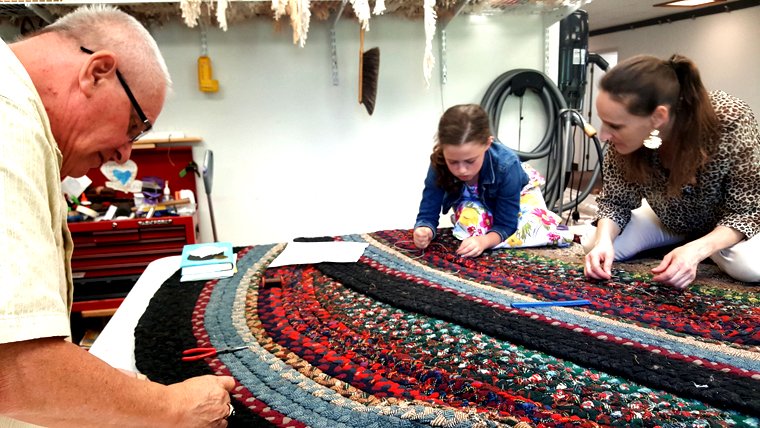ORIENTAL RUG CONSTRUCTION ELEMENTS
Two basic Oriental Rug construction elements (with some variations) are shared by the majority of these beautiful hand-woven rugs They are the Foundation and the Pile.
The construction of Oriental Rugs begins first with the making of the Foundation onto which yarn pieces will be knotted to form the 2nd element of the construction of these rugs...the Pile.
The rugs are all woven by hand on either a vertical or a horizontal loom.
Oriental Rug Construction Elements
The Foundation
The first of the 2 common Oriental Rug construction elements is the foundation, which typically consists of the following parts: warps and wefts.
Warp Threads
These are the threads or cords which are wrapped around the loom and run the length of the rug. They will usually be exposed as fringes or selvages at the ends of the rug.
Depressed Warps
Depressed warps occur when the wefts are pulled tightly from either side rather than put in with minimal tension. This will displace the warps into 2 levels. This structure (an upper warp and a lower or ‘depressed’ warp) will be more evident on the back of the rug unless the wefts are pulled very tight and then the depressed warps may not be visible even on the back of the rug.
This type of weaving can be found in many city rugs, especially Persian ones, resulting in a denser weave that is less flexible and should lie flat on the floor without any buckling or wrinkling (depending on the tension of the loom). These make an excellent choice for room-sized rugs in high traffic areas.
Weft Threads
These are inserted along the width of the loom and are placed perpendicular to the warp threads, making a crosshatch pattern of the foundation of the rug.
Knots
A row of knots is tied onto the warp threads. One or more weft threads are then placed over each row of knots and are beaten down by the weaver to hold them in place.
Sides
When the rug is completed, the rug is usually cut from the loom. The sides formed by the wefts may have to be secured by a finishing process chosen by the weaver, usually referred to as the serging.
Oriental Rug Construction Elements
The Pile
The pile is the second of the Oriental Rug construction elements and is formed by the yarn pieces that are hand-knotted onto the warps of the foundation of the rug. As noted above, one or more weft threads are placed over each row of knots and beaten down to hold them in place.
The knots of the rug create the specific pattern of each rug. These knots are usually tied in one of 2 ways:
Symmetric Knot
This knot is also called the Turkish or Ghiordes knot from its origin in Turkey. A yarn is placed in a loop around each of 2 warp cords, forming a knot which opens in the middle.
The symmetric knot is often used for thicker rugs because it provides a stronger consistency. It can be found in Turkey, the Caucasian area, and in the western parts of Iran, usually by Turkish and Kurdish tribes. It can also be found in some European rugs.
Asymmetric Knot
This knot is also called the Persian or Senneh knot. The yarn is placed in a loop around one of the warp threads and remains loose under the other. The 2 ends can emerge on either side of the warp. Again, between every row of knots, one or more weft threads are placed and are beaten down onto the knots to hold them securely.
The asymmetric knot makes possible the weaving of rugs with more details and with a higher density of knots.
The
asymmetric knot can be found in Persian workshops in Iran
and in India, Turkey, Egypt,
and China.
~~~~~~~~~~~~
There are 2 other knots that are not as common Oriental Rug construction elements of the pile:
Jufti Knot
This knot will be placed over four warp threads (rather than 2 as above). The weft or wefts are also placed as with the other knots. The knot itself can be symmetrical or asymmetrical.
The advantage to using a Jufti knot is that the weaving will go much faster. Unfortunately, the density of the knots will suffer, producing a rug that may be less durable.
This knot can be found in Meshad (Mashad) Khorasan Province Rugs from Northeast Iran.
Tibetan Knot
This knot is structurally different from the other knots. A temporary rod is placed along the width of the rug in front of the warp. The yarn, which will be considerably longer than with the other knots, is then placed around 2 warp threads and then around the rod. When the row is done, the loops around the rod are cut to create the knot.
Knot Density
Is it Really a Value
Determinant?
Although knot density is important to a rug's durability, it is the yarn that really makes the difference. A thicker yarn will have fewer knots and a finer yarn will have more knots.
It is the quality of the yarn that is important. The finer the wool that is used, the better the quality of the hand-knotted rug will be. A tighter-feeling rug may not necessarily have a higher knot density, but the tightness may be the result of how tightly the knots are compressed.
KPSI-Knot Per Square Inch in Oriental Rugs
KPSI is
a quality measure used to determine knot density in Oriental Rugs.
The video below is a 'How to' for quick and easy ways to determine the approximate KPSI in Oriental hand knotted rugs.
Use a quarter, and count 'em!
Questions About Oriental Rug Construction Elements?
The value of an oriental rug is determined by many factors. The quality of the yarn used in the various Oriental Rug construction elements (warp, weft, knot) will determine not only its value, but its durability as well. If you have any questions concerning the value or durability of any rug you already own or might be planning to purchase, we would be happy to answer any questions you may have.
A reputable rug dealer will allow you to take a rug with you to see how it will fit into your home. We would be happy to look at the rug to help you determine if it is being priced reasonably according to its construction and value.
You may reach us by phone or text at 607-272-1566. We are open from 8 to 5 Monday through Thursday, closing at 4:30 on Fridays. We are also open each Saturday of the month from 10 to 1. Please leave a message if we are closed. You can also contact us on the web, by email, and on Facebook. Let us answer your questions with our over 100 years of combined knowledge.
Top of Oriental Rug Construction Elements
"The Cleanest Clean You've Ever Seen."
by
ABC Oriental Rug & Carpet Cleaning Co.
130 Cecil Malone Drive Ithaca, NY 14850
607-272-1566
4 Step Guide to Quality in Oriental Rugs
Below is a very well-done short video on how to quickly judge quality in oriental rugs.
How to Tell if a Rug is Hand-Tufted, Handmade, or Machine Made
The video below explains some of the differences between Hand-Tufted Rugs, Hand-Made Rugs, and Machine-Made Rugs.




